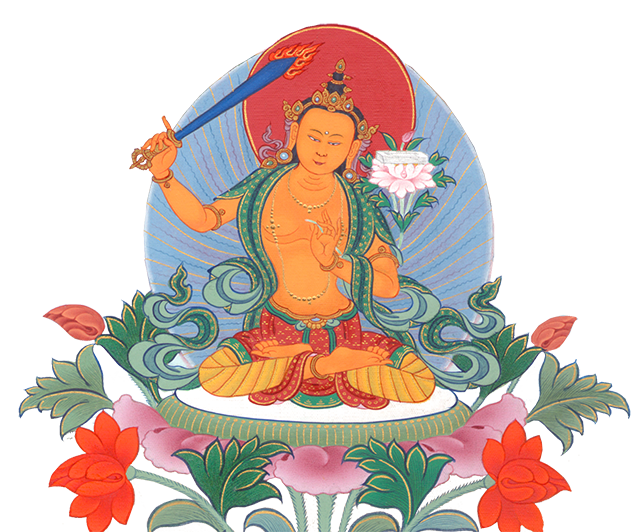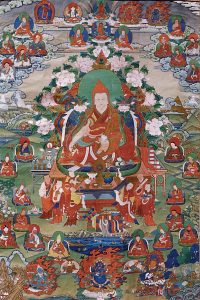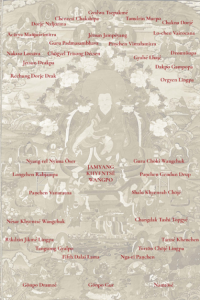Khyentse Lineage

About the Khyentse Lineage
Jamyang Khyentse Wangpo’s lineage can be understood to span both his previous and subsequent incarnations as well as the teacher and disciple lineages of the Khyentse tulku incarnations.
Previous Incarnations
Khyentse Wangpo is widely considered to be an emanation of Mañjuśrī in human form. Though initially recognized and enthroned as the rebirth of Tartse Jampa Namkha Chimé, a prominent Sakya scholar, Khyentse Wangpo was also later identified to be a tulku of Jigme Lingpa, the first “Khyentse,” known as Khyentse Özer. As clearly exemplified by his own memories of former lives, his rediscovery of treasure teachings that were previously revealed by past masters, and the statements of other important teachers such as Jamgön Kongtrul, Khyentse Wangpo was also the emanation of numerous other extraordinary adepts. These include key figures who helped shape Tibetan Buddhism over the centuries, such as the Tibetan king Trisong Deutsen, Vimalamitra, Gampopa, the Fifth Dalai Lama, Tangtong Gyalpo, and Lhatsun Namkha Jigme. Khyentse Wangpo inherited the lineage transmissions of these great adepts and revealed hundreds of treasures related to them. Several supplications to Khyentse Wangpo’s previous incarnations are found in his collections, including Generating Wonder and Glory and Amazing Line of Incarnations.
Khyentse Lineage Tree
This lineage tree only shows up to the third generation of recognised Khyentse tulkus who studied directly under Dilgo Khyentse Tashi Paljor.

 Tangka of Jamyang Khyentse Wangpo surrounded by his previous incarnations.
Tangka of Jamyang Khyentse Wangpo surrounded by his previous incarnations.
The tangka is from Dzongsar Monastery, photographed by Matthieu Ricard, originally published in Matthew Akester’s Life of Jamyang Khyentsé Wangpo
(Akester, Matthew, trans. The Life of Jamyang Khyentsé Wangpo. By Jamgön Kongtrul. Khyentse Foundation, 2020).
Subsequent Incarnations
Within a year of Jamyang Khyentse Wangpo’s passing on March 19, 1892, the first of a series of subsequent incarnations was born. Soon, tulkus of his body, speech, mind, qualities, and activity were recognized, including Jamyang Khyentse Chökyi Lodrö and Dilgo Khyentse Tashi Paljor. These tulkus received the transmissions and teachings from Khyentse Wangpo’s direct students, wrote commentaries to his works, and continued his tradition of revealing new treasures. Now, since the passing of Khyentse Wangpo’s first tulkus, a new generation has been recognized, including Dzongsar Khyentse, Jigme Khyentse, and Khyentse Yeshe. These teachers actively transmit the teachings and practices of Khyentse Wangpo to this day.
Embodiment of Rimé
Jamyang Khyentse Wangpo spearheaded the nineteenth-century non-sectarian Rimé movement. This movement was an effort to preserve and collect all major traditions of Tibetan Buddhism as well as Bön. Khyentse Wangpo, together with Jamgön Kongtrul, set about receiving, compiling, and disseminating teachings from all schools, especially many near-extinct lineages. Without Khyentse Wangpo’s efforts, many of these traditions would not have survived. Khyentse Wangpo organized the various Tibetan Buddhist teachings he received into the “eight great chariots”—practice lineages that entered Tibet from India: Nyingma, Kadam, Sakya, Marpa Kagyu, Shangpa Kagyu, Kālacakra, Zhije and Chö, and Approach and Accomplishment of the Three Vajras.
Khyentse Wangpo had hundreds of accomplished students from all traditions who continued his legacy, including Jamgön Kongtrul, Chokgyur Lingpa, Mipham Rinpoche, the 15th Karmapa, the 35th Sakya Trizin Tashi Rinchen, the 10th and 11th Tai Situpas, Dodrubchen Rinpoche, Loter Wangpo, Ayu Khandro, Adzom Drukpa, and many others.
Jigme Khyentse Rinpoche, one of Khyentse Wangpo’s subsequent incarnations, talks about what it means to embody the Rimé spirit:
